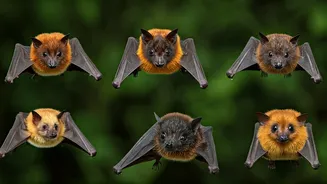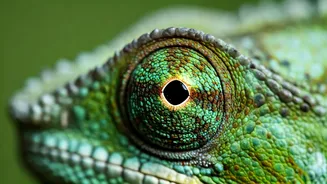Introduction to Bats
Bats are fascinating creatures belonging to the order Chiroptera, a group representing around 20% of all mammal species on Earth. They are the only mammals
capable of true flight, exhibiting a wide array of adaptations to diverse habitats. These nocturnal animals play crucial roles in their ecosystems, including pollination, seed dispersal, and insect control. Their diets range from fruits and nectar to insects and even small vertebrates, influencing the structure and function of their environments. Their conservation is important and often overlooked in today's world, but plays a crucial role in maintaining overall ecological balance. Various species of bats have adapted to inhabit different parts of the world, developing unique features and behavioral patterns to thrive in their respective environments.
The Egyptian Fruit Bat
The Egyptian fruit bat (Rousettus aegyptiacus) is a medium-sized bat species commonly found in Africa, the Middle East, and the Mediterranean region. These bats are known for their distinctive fox-like faces and play an important role as pollinators and seed dispersers, particularly of fruit trees. They primarily consume fruits, nectar, and pollen, contributing to the propagation of various plant species. They are unique in that they navigate using a type of echolocation that involves clicking their tongues, which allows them to find their way around, especially in dark caves and forests. These bats typically roost in large colonies within caves, contributing to the pollination of various plant species and making them an integral part of their ecosystem. The Egyptian fruit bat's presence is vital for maintaining the biodiversity and overall health of its environment.
The Striped Yellow-Eared Bat
The striped yellow-eared bat (Vampyressa macconnelli) is a small bat species found in Central and South America. Easily identified by the prominent yellow stripes on their ears, these bats are predominantly frugivorous, meaning that they feed mainly on fruits. Their dietary habits assist in the dispersal of seeds and the regeneration of forests. These bats exhibit remarkable adaptations to their habitat. The striped yellow-eared bat plays a key role in the health of forest ecosystems by contributing to seed distribution. They are known for their intricate social interactions and tend to live in small groups, often roosting in tents made from modified leaves. This bat species highlights the ecological complexity of neotropical forests and the importance of conservation efforts.
The Greater Horseshoe Bat
The greater horseshoe bat (Rhinolophus ferrumequinum) is a medium-sized bat species found across Europe, Asia, and parts of Africa. Named for the distinctive horseshoe-shaped structure around its nose, this bat is an insectivore, primarily feeding on moths, beetles, and other insects. The greater horseshoe bat is renowned for its sophisticated echolocation abilities, using high-frequency sounds to navigate and hunt in the dark. These bats are crucial in controlling insect populations, indirectly benefiting agriculture and human health by reducing crop damage and the spread of insect-borne diseases. Their survival depends on the preservation of suitable habitats like caves and old buildings where they can roost safely. The greater horseshoe bat is a vital component of diverse ecosystems, especially in regions with temperate climates.
Peter’s Dwarf Epauletted
Peter’s dwarf epauletted fruit bat (Micropteropus pusillus) is one of the smallest fruit bat species in Africa. Characterized by small size and the presence of 'epaulettes' or shoulder pouches in males, these bats are predominantly frugivorous and play a crucial role in dispersing seeds. Their diet consists mainly of fruits and nectar, contributing to the propagation of various plant species in their habitat. The peter’s dwarf epauletted fruit bats contribute to forest regeneration in the African savannas and woodlands, and also serve as pollinators. Their small stature and agility enable them to access food resources unavailable to larger fruit bats. They are important in areas where they help maintain ecosystem functions through plant pollination and seed dispersal.
The Honduran White Bat
The Honduran white bat (Ectophylla alba) is a tiny bat species found in Central America, specifically in the forests of Honduras, Nicaragua, and Costa Rica. It is distinguished by its pure white fur and a characteristic leaf tent, a structure constructed by cutting the veins of large leaves, which the bats then use as a roosting shelter. The Honduran white bat feeds primarily on figs, contributing to seed dispersal and forest regeneration in its habitat. These bats are an integral part of the Mesoamerican forest ecosystems, contributing to its health and diversity. Their survival depends on the conservation of forest habitats and fig trees, which they rely on for food and shelter.
The Brown Long-Eared Bat
The brown long-eared bat (Plecotus auritus) is found across Europe and parts of Asia. As its name suggests, this bat is easily identified by its exceptionally long ears. The bat is an insectivore, feeding primarily on moths, beetles, and other insects. The brown long-eared bat has evolved exceptional hearing capabilities, allowing it to detect the faintest sounds of prey in the darkness. It is an efficient aerial hunter, catching insects in flight. These bats are found in diverse habitats, from woodlands to urban parks, and frequently roost in buildings. The conservation of these habitats is essential to support the species and to maintain insect population control. These bats play an essential role in insect control, especially in agricultural landscapes.
The Big Brown Bat
The big brown bat (Eptesicus fuscus) is a widespread species found throughout North and Central America. The species is characterized by its large size and brown fur. They are insectivores and are particularly effective at consuming a wide variety of insects, including crop pests. These bats roost in a variety of places, from caves and buildings to bridges, demonstrating great adaptability to various environments. The big brown bat plays a substantial role in reducing the populations of harmful insects, making them beneficial to agriculture and the local ecosystems. They also exhibit interesting social behaviors, often forming maternity colonies in the spring and summer months, which are crucial for raising their young. The big brown bat's contribution underscores the broader ecological significance of bat species in the Western hemisphere.













